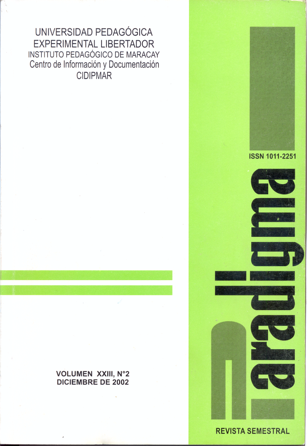LA TEORÍA ATÓMICA DE DALTON DESDE LA PERSPECTIVA DE LA NUEVA FILOSOFÍA DE LA CIENCIA: UN ANÁLISIS DE LA IMAGEN REFLEJADA POR LOS TEXTOS DE QUÍMICA DE BACHILLERATO
Resumen
RESUMENLos estudios más recientes indican que los textos universitarios de química general reflejan un enfoque de la evolución de la ciencia que contradice los eventos históricos. La ciencia no se desarrolló mediante acumulación de conocimiento verificado por los datos experimentales, sino mediante la competencia de puntos de vista conflictivos que conducen a un aumento cada vez mayor del poder heurístico/explicativo de las teorías (Lakatos, 1970). El objetivo de esta investigación, es evaluar la imagen de la ley de las proporciones definidas y múltiples, en el contexto de la teoría atómica de Dalton, reflejada por 26 textos de química de bachillerato (16 de noveno grado y 10 de primer año ) y su grado de coincidencia con el enfoque actual de la Historia y la Filosofía de la Ciencia. Cinco criterios racionales que reflejan el punto de vista actual de la Filosofía de la Ciencia, fueron aplicados para evaluar cualitativamente el enfoque de los textos en los temas señalados. Uno de los criterios más resaltantes, trata la controversia entre Dalton y Gay-Lussac: La historia muestra que la teoría atómica de Dalton explicó la ley de los volúmenes de combinación de Gay-Lussac. En contraste, la versión positivista afirma que la ley de Gay-Lussac dio origen a la teoría atómica. Los resultados indican que, solamente un texto menciona este criterio, ninguno lo describe satisfactoriamente. En conclusión, los textos analizados reflejan un enfoque positivista-inductivista de la evolución de la ciencia, ignorando que el desarrollo de teorías implica controversias. La inclusión de la historia de la ciencia en los textos, puede contribuir a una visión más dinámica del desarrollo del conocimiento científico, y por ende más estimulante para los estudiantes.Descriptores: Historia y Filosofía de la Ciencia, Enseñanza de las Ciencias, Teoría de Dalton, Leyes de las Proporciones Definidas y Múltiples.ABSTRACTATOMIC THEORY OF DALTON FROM THE PERSPECTIVE OF THE NEW PHILOSOPHY OF SCIENCE: AN ANALYSIS OF THE IMAGE REFLECTED BY HIGH SCHOOL CHEMISTRY TEXTSRecent studies indicate that university level general chemistry textbooks reflect a vision of the development of science that contradicts historical events. Science did not develop through the accumulation of verified knowledge based on experimental data, but rather through conflicting theories that increase their heuristic/explanatory power (Lakatos, 1970). The objective of this study is to evaluate the image of the laws of definite and multiple proportions (in the context of Dalton’s atomic theory) reflected by 26 secondary level chemistry textbooks (16 of 9th grade and 10 of 10th grade) and the degree to which they coincide with the current perspective of history and philosophy of science. Five rational criteria were used to evaluate the textbooks. One of the criteria dealt with the controversy between Dalton and Gay-Lussac: Historical events show that Dalton’s atomic theory explained Gay-Lussac’s law of combining volumes. In contrast, the positivist version states that Gay-Lussac’s law gave origin to the atomic theory. Results obtained show that only one textbook mentioned the criterion and none described it satisfactorily. It is concluded that textbooks analyzed reflect a positivist-inductivist perspective of the development of science and ignore the role played by controversies. Inclusion of the history of science in the textbooks can contribute towards a more dynamic perspective of the development of scientific knowledge and thus more stimulating to students.Key words: History and philosophy of science, Science teaching, Dalton’s theory, Laws of definite and multiple proportions.Descargas
La descarga de datos todavía no está disponible.
Publicado
2015-11-18
Métricas
- Visualizaciones del Artículo 249
- PDF downloads: 87
Cómo citar
Páez (UEBRCM, Cumaná-Venezuela), Y., Rodrígez (UDO, Cumaná-Venezuela), M. A., & Níaz (UDO, Cumaná-Venezuela), M. (2015). LA TEORÍA ATÓMICA DE DALTON DESDE LA PERSPECTIVA DE LA NUEVA FILOSOFÍA DE LA CIENCIA: UN ANÁLISIS DE LA IMAGEN REFLEJADA POR LOS TEXTOS DE QUÍMICA DE BACHILLERATO. PARADIGMA, 23(2), 97-122. https://doi.org/10.37618/PARADIGMA.1011-2251.2002.p97-122.id281
Sección
Artículos























































